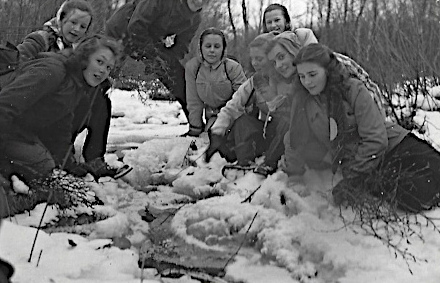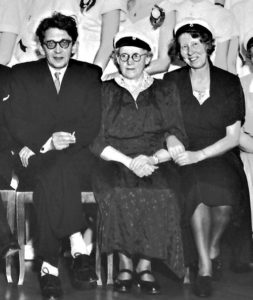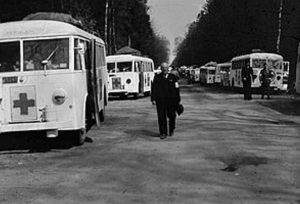
Frostavallen 1948 – Britt, Siv on the left, Karin, Ragnhild on the right – Mother must have lent me a camera.
The world was a different one from today at the time when I went to grade school and secondary school. One thing that would seem shocking today – there were obligatory classes in Christianity. It was not teaching of different religions, but Christianity and nothing else. The teaching of Christianity (kristendom) changed in the sixties and became ‘knowledge of religions’ (religionskunskap). Obligatory teaching of Christianity would have been impossible today for obvious reasons, since there are so many students who are not Christians at all. There are Muslims, Jews, atheists, and not all the so-called Christians are Lutherans either. Just assuming that all the students were Christians and Lutherans was absurd.
Goodness, in grade school, we even read parts of the Bible, here and there, only the New Testament, and we had to learn hymns by heart. How backward could they be, the people in the education department who made the decisions concerning our school curricula! Those were indeed the Middle Ages. Only in the last year of Gymnasium did we learn a bit about other religions, but not in any depth at all.
Every year from the first grade in elementary school and through to secondary school graduation, studentexamen, Christianity was a compulsory subject. Two hours a week, on a par with history, geography, biology and such subjects. More important subjects, such as English and Swedish got three or even four hours a week. The one and only subject that was ever taught five hours a week was Latin in Gymnasium.
A special honorary paragraph is due here to our incredible English teacher.
Her name was Stina Lindeberg and she was no doubt the most outstanding English teacher in all of Sweden, certainly at the time. We had the same teacher from our first year of English until graduation, that is six years, simply because she insisted on staying with us.
The way she motivated us was remarkable. I believe that most of us saw it as a given that English was our most important and also our favorite subject. In Gymnasium there was no more piecemeal homework. She lent us books of her own; we picked one we thought looked interesting and we read two-week assignments. At the end of an assignment, we gave a summary report to the class about the section of the book we were reading. English was the language that was spoken in the class. It did mean, for me at least, a lot of cramming on the Sunday before the report was due in class, but I accepted that without any problem. The advantages to this system were enormous.

My much beloved and admired Stina Lindeberg with a nice smile on the right. On the left is Sture Silverberg, our math teacher. In between is our religion teacher, Maria Cronquist.
In fact, I remember now that this started with ‘Winnie the Pooh’ in one of the lower grades. One at a time, we read a section of this wonderfully funny book, and one at a time we gave a report to the class. As a parenthesis, my close friends Aina and Harriet had to repeat a year because they flunked Latin. Laziness certainly since they were both bright. They decided to change schools and continue at Katedralskolan in Lund. Their English grades soared from medium/good to the top grades.
Stina Lindeberg’s classes were used not to check homework but for conversation and discussion. What a difference from our boring and incompetent German and French teachers. “Siv, Karin, Gertrud…,read / translate today’s text!” Even if I hadn’t prepared it, I think I usually managed fairly well to give a satisfactory performance. Except one time when I was caught not having even taken a look at my French homework.
We were reading Prosper Mérimée’s Colomba (or at least I think it was Colomba), but today I don’t remember in the least what the story is about. And still I had to teach it myself when I substituted for one term in Helsingborg lycée for girls in the fall of 1957, teaching French and Swedish. I had no say in the choice of book to read with the class, and so I was stuck with Colomba.
One day I was caught red-handed. “Siv Molin, translate today’s text!” said our French teacher, Anders Billquist. (The male teachers addressed us by our full names back in those days. What a drag!) The text I had to translate was about Colomba who had spent the night sleeping in a cave. As he woke up he caught sight of a lion who had also been sleeping in a far corner of this cave. Seeing the lion, “il se dressa sur son séant” (He sat up). I forged ahead and guessed “He got dressed sitting up…”. General laughter and I am not sure that our kindly French teacher Billquist did not join in the laughter instead of shaming me for not having done my homework. I later caught up on my level of French by reading André Gide’s “La symphonie pastorale” as my special project.
German was the same. Why this pedagogically ignorant preference for boring books that were uninteresting to us and often far too difficult? Why not try to motivate us by having us read books we would enjoy? I later chose to read La Symphonie pastorale by André Gide as my special French project, and I loved it.
We referred to our teachers by their last names only, when talking about them, which John finds very odd. No Mrs or Miss or Mr. Until the day of the baccalauréat this went on, or maybe rather at the big dinner party we held for all our teachers in a very nice restaurant outside of Malmö, with sketches, singing and good food, when we were officially told that now we should say ‘du’ to them, and use first names.
At this party , what I remember best was my beautiful and top student friend Karin and I doing a singing skit where I was the countess sitting on a chair and Karin was a troubadour who came in through her window. The husband-count is supposed to be away on a crusade (horrible things), but suddenly, as the countess has invited the troubadour into her room with the open window, the count comes in through the hallway, etc. It was really funny and everybody seemed to appreciate it. We talked about it later at a student reunion, but we could not remember who was the count. A friend called Harriet said she was the count, and later Karin and I both said “Impossible. Harriet can’t sing.” We still don’t know, but there was a lot of laughing.
Getting back to our English classes and incomparable Stina Lindeberg – My great friend Britt recently told me a thing that had completely escaped me. As students joined our Gymnasium classes from other schools and were subjected to English classes where only English was spoken and where you were expected to speak it fluently, some of the newcomers literally broke down in tears.
However, they were intelligent students and little by little they caught up. In those days, the students who went through Gymnasium to pass the baccalauréat were all select, and through all the written and oral exams we had to go through, and the cramming for the orals, if there were any weak students they fell through in those exams. In all of Malmö there were only 30 girls graduating that year, but I am sure the numbers kept increasing, and very soon the final exams were done away with.
There were only two branches in Gymnasium in my days, the Latin branch (Latinlinjen) and the math-and-science branch (Reallinjen). Very soon thereafter a new branch was created, called the general branch (Allmänna linjen) where neither Latin nor high-level math was taught. In French the word is filière and there are numerous different filières today in France. They also still keep the final exams.
One more thing that today seems medieval was the morning prayers both in grade school and in secondary scholo (which I call lycée since it has very little in common with U.S. high school). Listening to a brief sermon and then hymn singing. A student in my class played the organ on the balcony of the auditorium, while we all sang from our hymn books. Oh my god! What a backward era this was. Did they do the same in Germany I wonder, a country that influenced our culture so intensely? Or were Nazi morning assemblies exclusively dedicated to patriotic lecturing and singing? Very likely.
In secondary school, right at the end of the hymn and after the person who had given the little sermon had stepped off the podium, our elderly woman principal, Marianne Mörner, would often get up on the podium and firmly tell us, in anything but a devout tone of voice, things such as “I will not see a gum-chewing girl in my school, and the only difference between a gum-chewing girl and a cow is the intelligent look in the eyes of the cow.” I bet she thought she had found a very clever way of expressing herself. There was usually some kind of strict rule of behavior being spelled out to us by tall and sinister-looking Marianne Mörner after the hymn singing had died down. But only just died down.
Mademoiselle Mörner had been the principal of our school ever since 1929, long before the major and modern addition to the old school was built. She was a linguist and a docent in Romance languages at Lund University. Now she became the ‘mother’ of all her secondary school girls and the number grew every year, as more and more girls went on to studentexamen. Here is just a little incident that shows Marianne Mörner’s other side.
In the lower grades, “junior high school “or so, we had sewing classes for our first two years and cooking (home economics) the third year. In second grade we were supposed to sew a dress. My dear friend Aina and I thought it would be nicer to make a skirt and a blouse, so we were of course allowed to do that. I learned to sew on an electric machine, since at home we only had a treadle machine. We made red wide skirts and white blouses and they really looked very nice. One day we were wearing them in school both of us, and as we walked down the hallway, here comes Marianne Mörner towards us. She was so delighted to see us, two pretty little girls in identical outfits, that she stopped and talked to us. She was over-brimming with delight when she learned that we had made them ourselves – in sewing class.
Mörner, as we usually referred to her, retired the year we entered gymnasium, 1948, and I believe the school that same year ceased to be a partly private school. It also soon thereafter ceased to be a girls’ school only. Bertil Block became our new principal, and the school gradually lost its exceptionalism.
Marianne Mörner was a tall, skinny spinster whose only close friend on the faculty was Ingeborg Tegnér, my philosophy teacher and my sister Gun’s English teacher. This dried-out little woman was the descendant of our ‘great national poet’, Esaias Tegnér, one of the most outstanding members of the Gothic League (Götiska Förbundet), from the early 19th century – an association of poets and writers who had clear nationalistic and patriotic features, an attempt at reviving the Viking spirit. Oh well, worse things have happened in history. The two spinsters found great satisfaction in knowing that they were both members of the Swedish intellectual and social elite. Mörner’s father was Olof Stellan von Mörner, Ryttmästare (officer in the cavalry) of a German regiment and owner of vast properties in Germany as well as in Sweden, inherited in his family from the 16th century.
_______________
In the late 1990s when I was working on a big project about the escape over to Sweden by Danish Jews, which began in October 1943, I managed to get an academic paper from a library in Uppsala about Nazism in Sweden during and before World War II. I read all sorts of books on the subject of Danish Jews and even about rescue organizations for German Jews set up in Berlin, and I was fascinated by my project. In the paper about Nazism in Sweden – what did I find? Marianne Mörner was one of the pillars of the aristocratic Nazi party. I was not surprised. There were at least three different Nazi parties in Sweden at the time, and one was especially dedicated to Swedish aristocratic admirers of Hitler. The three parties, for workers, farmers or the upper classes, were all named “National Socialist” this or that.
This woman had a historic ancestor, Baron Carl Otto Mörner (Friherre Mörner), the man who took it upon himself in 1810 to go to Paris to ask le Maréchal Bernadotte to become the Swedish Crown Prince. Prince Karl August, son of the king of that time, Karl XIII, had suddenly died and various political groups were vying for a candidate who would suit their own ambitions. Baron Mörner cheated them all by hurrying to Paris and persuading Jean Baptiste Bernadotte to become the Swedish Crown Prince. How he got away with this scheme is a mystery.
Bernadotte was one of Napoleon’s marshals and he had even taken over Napoleon’s own betrothed, Désirée Clary, and married her in 1798. When he now made his entrance into Sweden, he was accompanied by his wife Désirée, who became the Queen of Sweden a few years later, one big step better than being Napoleon’s betrothed, especially since Napoleon in the meantime had married Joséphine de Beaumarchais. As King of Sweden from 1818 Jean Baptiste became Karl XIV Johan. He governed Sweden for 34 years, but he never learned to speak Swedish. So when Napoleon was dying on the remote island of Sainte-Hélène, (in the south Atlantic ocean) his marshal Bernadotte and his former betrothed were king and queen of Sweden.
_______________________
My research into Swedish Nazism took me much further, however, than to the upper class National Socialist party of which Marianne Mörner was apparently a pillar. As I already knew, Sweden made a pact with Hitler, promising to deliver iron and arms, (cannons from Bofors, Boforskanoner), and also allowing German trains to transport soldiers and arms through Sweden to Narvik in the north of Norway, and to generally look the other way when the Germans needed their silent collaboration. So much for Swedish so-called neutrality. I now learned much more about the stand-off position of Swedish bourgeois Jews, who kept a low profile during the war years – be they Bonnier or Josephson . I learned about the general fear of the Swedish war-time coalition government to interfere with Nazi demands. They felt they were walking a tight-rope so as to avoid being occupied like so many other nations around us.
Denmark was an occupied country very different from Norway or the continental German-occupied countries. Norway was ruled by the collaborator Vidkun Quisling, but the country was teaming with resistance fighters, many of whom made their way into Sweden across the somewhat indistinguishable border in the middle and the north of Norway.
The big difference was that Germany was very much dependent on Denmark for food for the military, and so this fertile country got special treatment as a ‘good’ occupied nation. Until October 1943, their Jewish population was left undisturbed, to show the world what a benign occupier Germany really was. It got to serve as a model, and the Germans pointed to Denmark as proof of their harmless intentions as an occupying power. Sweden went along with German demands, though. It even happened that German Jews, who had managed to make it over to Sweden via Denmark, were forced to return to Denmark. All this suddenly changed in October ’43.
In September 1943, a drastic order was issued from Hitler personally. He suddenly decided that all Danish Jews were to be rounded up and deported to German concentration camps. This took place during the night of Rosh Hashanah, October 1. However, thanks to Georg Ferdinand Duckwitz, a German working in Copenhagen as a naval specialist for the German transportation department, the dreadful news was leaked to Hans Hedtoft, president of the Danish Social Democratic Party, who then told Rabbi Marcus Melchior about the urgent need to spread the news among the entire Jewish population, especially in Copenhagen. The leaking of Hitler’s new dictate took place just two days before the fatal night. Most Jews managed to go into hiding, some just with neighbors, others with families they more or less vaguely knew in the countryside.
It was also of great importance to the fate of the Jews that the SS forces in Denmark were far from numerous enough to really guard the coastline to Sweden. Many of the German soldiers and most of the Danish police purposely looked the other way when refugees were sighted near the coast or transported inside a truck along the east coast.
The 95% of the Danish Jews who were saved went through enormous ordeals to finally make it over to Sweden, mostly in small fishing boats and even canoes, and always during the night of course. Many refugees drowned on nights when the winds were rough in the Sound. But 7,000 Jews out of 7,500 made it safely across the Sound, which must be considered to have been something of a miracle. Most of the remaining Jews were sent to Theresienstadt concentration camp in former Czechoslovakia and actually came back unharmed at the end of the war. More about that below.
The Swedish government learned about the radical change in the German stand concerning the Danish Jews and since Germany was in fact a broken nation on all fronts, this changed the stand of the Swedish government entirely.
On the east front Hitler went on giving orders for Stalingrad, “Not one step back”, which meant the senseless slaughter of yet more thousands of German soldiers. The definitive end of that horrible many-months-long winter war was in February 1943.
An order like this one is easy to give for Hitler in Berlin, but impossible for the half-starved and half-frozen German soldiers during the onslaught of Russian soldiers, who were well prepared for the climate. Hitler was, at this time so insane that an attempt, which failed, was made by his own generals to kill him.1
The German war in Africa was lost. Field Marshal Rommel, the leader of the Afrika Korps, was a sick man who went to Germany to beg Hitler to order a stop to the fighting. The battle for El Alamein was lost in 1942 and any sane man could see that the war in Africa was unwinnable. But Hitler was not a sane man. He ordered Rommel, sick and in despair, to immediately go back to Africa and make sure he got to Egypt.
Even the naval war in the Atlantic was lost and everything pointed to a soon upcoming surrender by the Germans. That was the situation when the Swedish government finally broadcast a message over to Denmark in the last days of September 1943, announcing that all Danish Jews and members of the resistance were welcome to Sweden .
My eyes were teary and my heart beat with joy and emotion, when I read about the strong searchlights being focused on the Danish boats, but this time, at last, by friends.
The little boats arrived at night in Swedish territory, and the loudspeakers announced “You are now in Swedish waters and we wish you welcome to Sweden.” All kinds of Swedes were ready at the landing with warm clothes, warm food and warm welcomes.
A fairly large number of Danish Jews were rounded up nevertheless, in spite of the wonderful cooperation and support by the Danish people, and those who did not manage to escape were taken to the concentration camp Theresienstadt in occupied Czechoslovakia. Miraculously, almost all of them survived, thanks to regular visits by the Danish Red Cross.

Folke Bernadotte (1895-1948) was the leader of the action that brought back around 25,000 prisoners from the German concentration camps —(Wikipedia
2 The Danish Red Cross also brought food and made sure that living conditions were bearable. Also, “The Danish Aid Corps” arranged for cars and buses to transport the prisoners, and as an example, Folke Bernadotte’s white buses carried away, in one day only, 423 liberated prisoners.
In the spring of 1945 innumerable Scandinavian prisoners were saved from German concentration camps through Bernadotte’s intervention. He had personally negotiated their release with Heinrich Himmler. 3
Continued: Chapter 6 (Part 2) – Studies at Lund University
- On 20 July 1944, Claus von Stauffenberg and other conspirators attempted to assassinate Adolf Hitler, Führer of Nazi Germany, inside his Wolf’s Lair field headquarters near Rastenburg, East Prussia ↩
- The Swedish Red Cross expedition to the German concentration camps in March-April 1945 was the largest rescue effort inside Germany during World War II. By a conservative estimate, over 17,000 prisoners were transported via Denmark to Sweden up until 4 May 1945. This expedition, though formally a Red Cross detachment led by Count Folke Bernadotte af Wisborg, Vice-President of the Swedish Red Cross, was in reality a Swedish Army detachment whose costs were covered by the Swedish Government. All vehicles were painted white so that they should be easily distinguishable from German vehicles, especially from the air, and so are known as ‘the White Buses. ↩
- “Heinrich Himmler, Reichsführer of the Schutzstaffell (Protection Squadron; SS), was one of the most powerful men in Nazi Germany and among those most directly responsible for the Holocaust.” ↩





What a wonderful English teacher you had! Not even today are there many of such modern teachers.
It was also interesting to read about the destiny of Danish jews.
Oh wow, Sara, you read this chapter too. I just rewrote it and posted the final version yesterday. I added all the part about the teachers and WWII. Yes, it was indeed fascinating doing that research, reading all those books back in the late 90s. I hope you saw the pictures I just added this morning. My friend Britt in Stockholm actually mailed me the picture of the three teachers, including Lindeberg and Silverberg. It’s from our big dinner and entertainment for all our teachers at Vellinge gästis, and I, for some reason, never bought that picture.